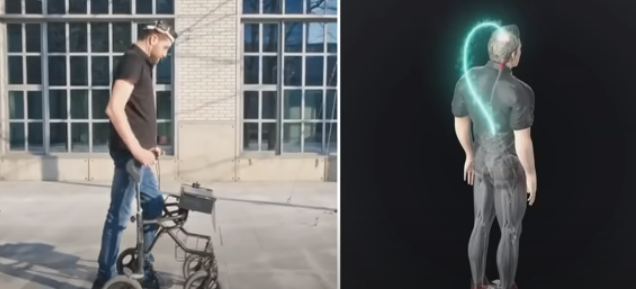Paralyzed man walking again with implants for brain and spinal cord
Revolutionizing Medicine: Implants in the Brain and Spinal Cord
The field of medical science is witnessing remarkable advancements in the realm of implants, particularly in the brain and spinal cord. These cutting-edge technologies are revolutionizing the way we understand and treat various neurological conditions. In this article, we delve into the world of brain and spinal cord implants, exploring their potential applications, benefits, and ethical considerations.
Brain Implants:
Brain implants, also known as neural implants or neurostimulators, are devices that interface with the brain to modulate its activity. They are used in the treatment of various neurological disorders, including Parkinson’s disease, epilepsy, depression, and chronic pain. These implants typically consist of electrodes that are surgically placed in specific regions of the brain to deliver electrical impulses.
a) Deep Brain Stimulation (DBS):
DBS is one of the most common brain implant procedures. It involves the insertion of electrodes into deep brain structures, such as the thalamus or subthalamic nucleus, which are responsible for regulating movement and mood. The electrical stimulation delivered by the implant helps alleviate symptoms associated with conditions like Parkinson’s disease and essential tremors.
b) Brain-Computer Interfaces (BCIs):
BCIs establish a direct communication pathway between the brain and an external device, allowing individuals to control computers, prosthetic limbs, or assistive technologies using their thoughts. BCIs hold immense potential for enhancing the quality of life for people with paralysis or severe motor impairments.
Spinal Cord Implants:
Spinal cord implants, also known as spinal cord stimulators, are used to manage chronic pain and restore motor function in individuals with spinal cord injuries. These implants work by delivering electrical pulses to the spinal cord, blocking pain signals or activating specific nerves to improve mobility.
a) Pain Management:
Spinal cord implants offer an alternative for patients suffering from chronic pain who have not found relief from traditional treatments. By interrupting pain signals before they reach the brain, these implants can provide significant pain reduction and improve the overall quality of life for patients.
b) Restoring Motor Function:
In cases of spinal cord injuries, implants can be used to stimulate specific nerves in the spinal cord, bypassing the damaged areas and enabling individuals to regain control over their limbs. While the technology is still in its early stages, spinal cord implants hold great promise for restoring mobility in paralyzed patients.
Ethical Considerations:
As with any medical technology, brain and spinal cord implants raise ethical concerns that must be addressed. Key considerations include ensuring patient autonomy, informed consent, privacy, and equitable access to these treatments. Additionally, there is an ongoing need for comprehensive research to understand the long-term effects and potential risks associated with these implants.
Implantable devices in the brain and spinal cord represent groundbreaking advancements in the field of neurology. From alleviating symptoms of neurological disorders to restoring motor function and reducing chronic pain, these implants offer hope for countless individuals worldwide. While ethical considerations persist, continued research and responsible implementation of these technologies will unlock their full potential and transform the lives of those in need.
A man who suffered leg paralysis in a cycling accident 12 years ago has regained the ability to walk through the use of brain and spinal cord implants. In a study published in the journal Nature, it was reported that the brain-spine interface (BSI) implanted in Gert-Jan Oskam has remained stable for a year, enabling him to stand, walk, climb stairs, and navigate challenging terrains. Interestingly, Oskam even exhibits some control over his legs when the BSI is deactivated. During a news briefing, Oskam expressed his belief in the possibility of walking again and his satisfaction with the outcome.
Following the accident in China, Oskam anticipated receiving assistance upon returning to the Netherlands; however, the technology at that time was not advanced enough. Oskam had previously taken part in a trial conducted by Grégoire Courtine, a neuroscientist at the Swiss Federal Institute of Technology, who also contributed to the recent research. In 2018, Courtine’s team discovered that stimulation of the lower spine using technology could help individuals with spinal cord injuries regain their ability to walk. Oskam’s progress had reached a plateau after three years.
For the current study, the research team established communication between Oskam’s brain and spinal cord using a digital bridge. Oskam underwent 40 sessions of neurorehabilitation during the study, and he can now walk distances of at least 100 meters (328 feet) depending on the day.
Courtine explained that they were able to interpret Gert-Jan’s thoughts and translate them into spinal cord stimulation to restore voluntary movement. The researchers aim to further advance the technology by miniaturizing the required hardware, as Oskam currently carries it in a backpack. Additionally, they are exploring the potential for similar devices to restore arm movement.
Recent years have witnessed notable progress in the treatment of spinal cord injuries. A study published in February in Nature revealed that targeted electrical pulses delivered to the spinal cord can enhance arm and hand mobility after a stroke. The researchers involved in Oskam’s case believe that their technology can eventually restore movement in arms and hands as well, and they aspire to apply these advancements to aid stroke patients with sufficient time and resources.
The PakSoil News Team is a dedicated group of journalists, editors, and analysts committed to delivering accurate, timely, and balanced news coverage. From politics and business to culture and community, we bring you stories that matter — verified, unbiased, and written with integrity.



